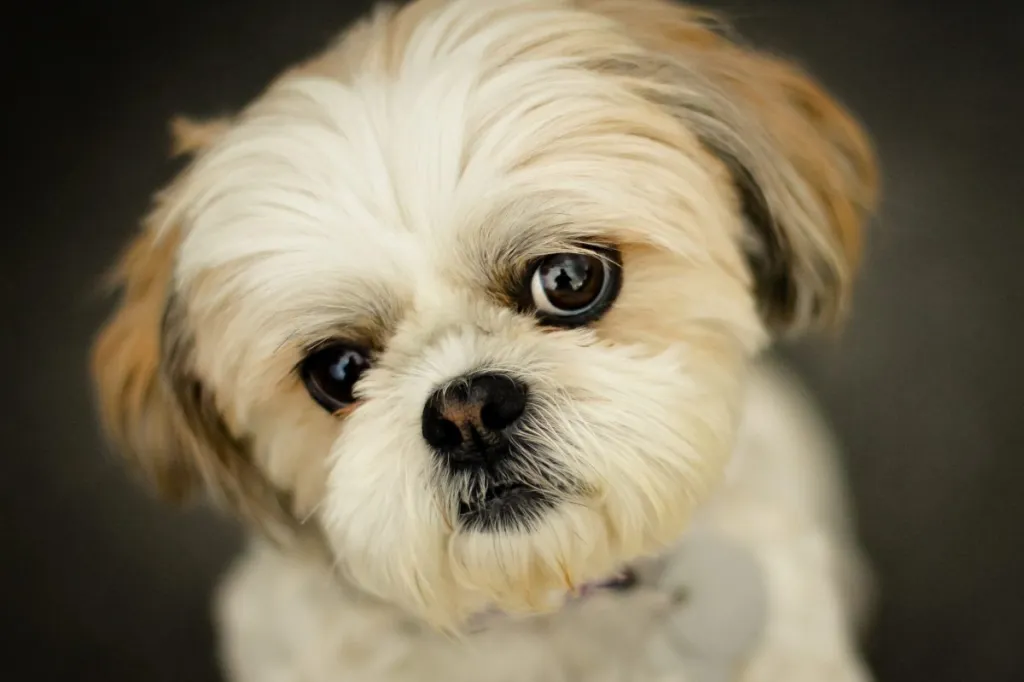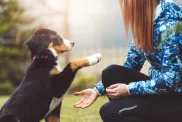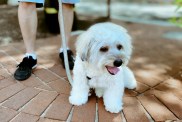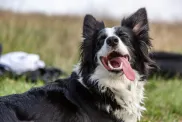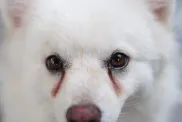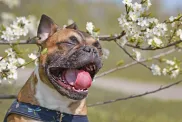The name Shih Tzu means “little lion,” but there’s nothing fierce about this dog breed. This pooch is a lover, not a hunter. Bred solely to be companions, Shih Tzus are affectionate, happy, outgoing house dogs who love nothing more than to follow their people from room to room. Since ancient times, they’ve made themselves comfortable on the laps of people from all walks of life, even emperors!
In recent years, however, pet parents have started taking Shih Tzus off their laps and into dog sports, training them for obedience, rally, and agility competitions. They make great family pets who get along with other animals and even children, so long as kids know how to gently handle and play with a small pup. If you’re looking for a small best buddy who who can adapt to apartment living, join you on the couch for cuddles, and shower you with unconditional love, this may be the dog for you.
Quick Facts
- Origin: Tibet, China.
- Size: Small; typically weighing 9 to 16 pounds (4 to 7 kilograms).
- Breed Group: Toy Group.
- Lifespan: 10 to 16 years.
- Coat: Long, flowing double coat that requires regular grooming to prevent matting.
- Temperament: Friendly, affectionate, and good with families and other pets.
- Exercise Needs: Moderate; daily walks and playtime are sufficient to keep them healthy.
- Training: Intelligent but can be stubborn. Consistent, positive reinforcement-based training works best.
- Grooming: High maintenance due to their long coat; regular brushing, bathing, and occasional trimming are necessary.
- Health: Prone to respiratory issues, dental problems, eye conditions, joint problems, and other genetic health concerns.
- The breed went briefly went extinct in China during the Communist revolution
- Because of their super-friendly nature and adorable looks, these dogs have starred in several movies. One of these films is the funny mockumentary called “Best in Show” (2000), where a Shih Tzu named Miss Agnes stole the spotlight. Another big movie role for this breed was in the dark comedy crime film “Seven Psychopaths” (2012), featuring a Shih Tzu named Bonny. But the most impressive Shih Tzu performance was in the animated flick “The Secret Life of Pets 2” (2019). In this one, a Shih Tzu named Daisy rocked the screen as a major character, and she was voiced by American actress Tiffany Haddish.
Shih Tzu Pictures
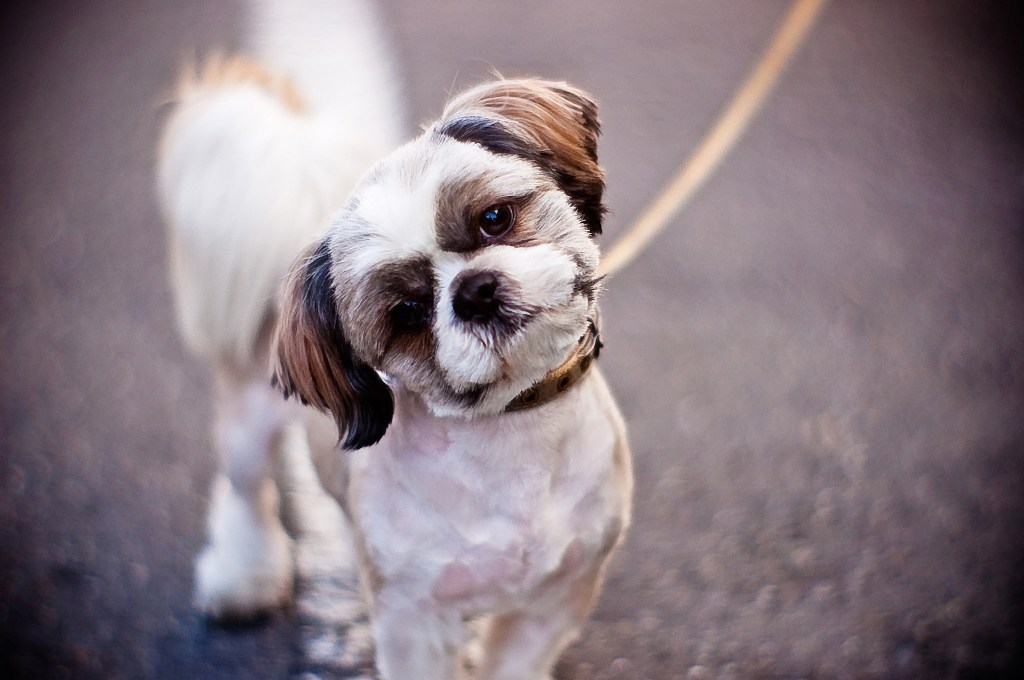
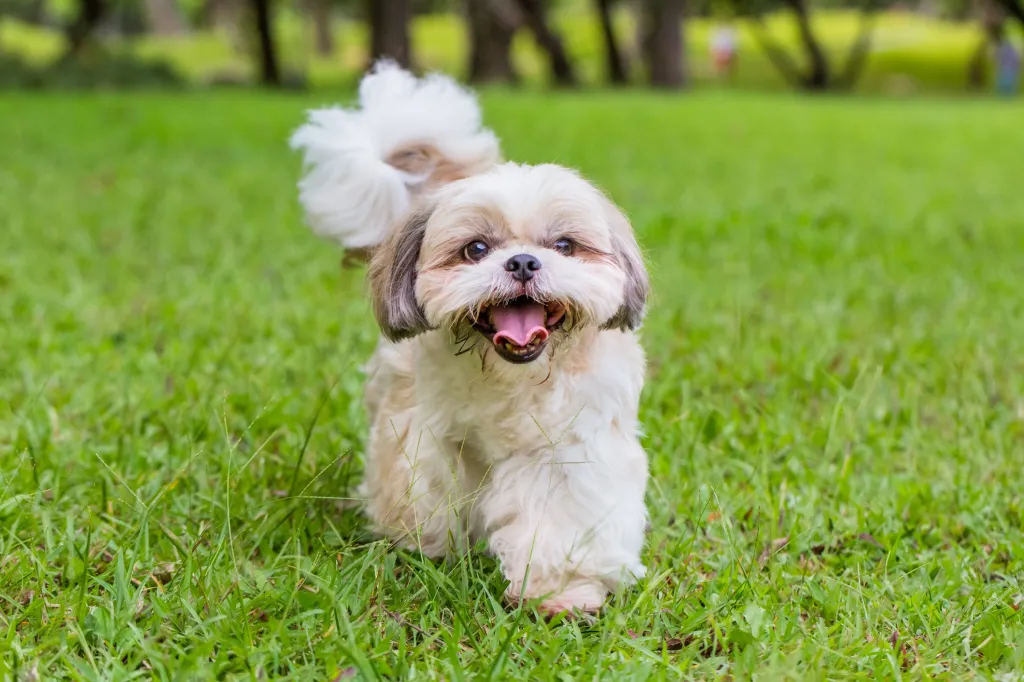
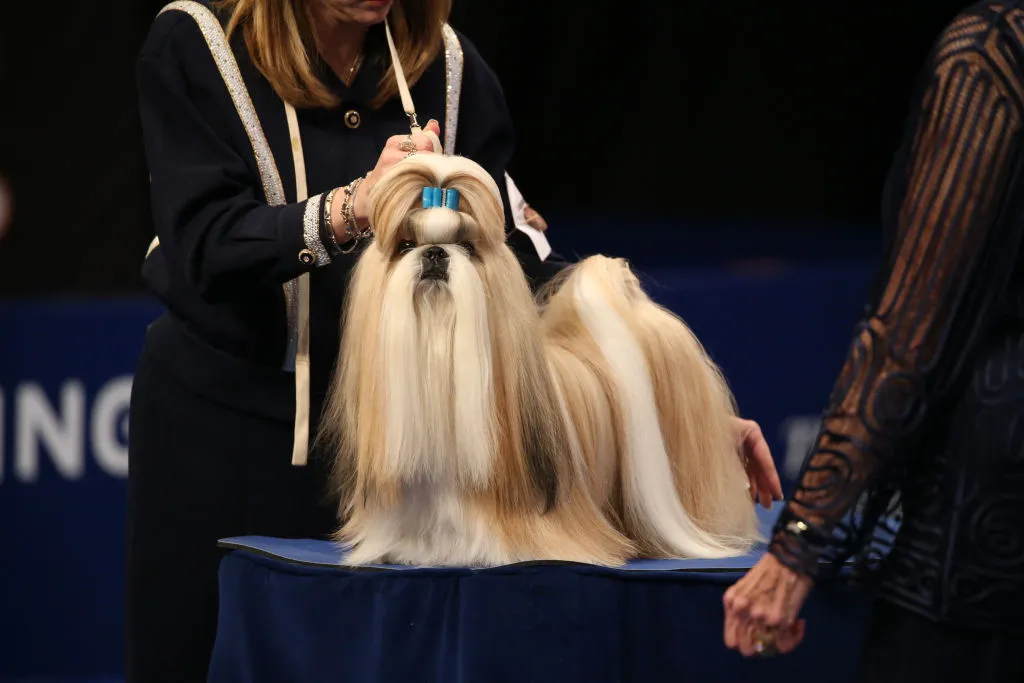
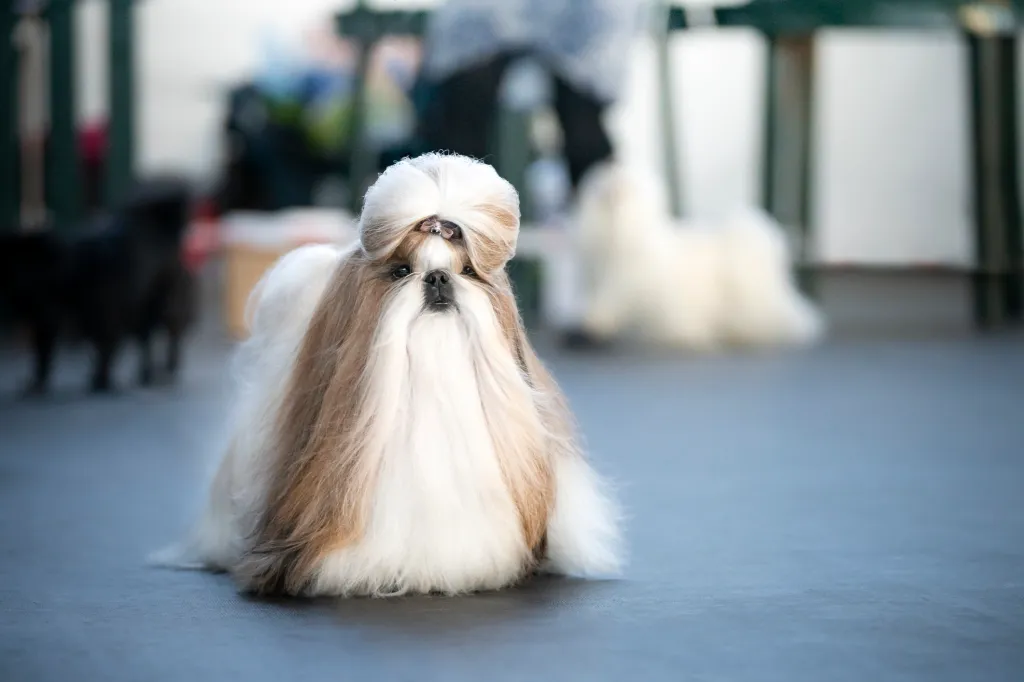
Adaptability
-
Adapts Well To Apartment Living
Looking for the best dog for your apartment? Contrary to popular belief, the suitability of dogs who adapt well to apartment living goes beyond its size. Apartment dwellers have a myriad of dog breeds to choose from as potential companions, with various factors to consider. Some large breeds can adapt well to apartment living and have lower activity levels. Others may require more space and possess higher energy levels. On the other hand, certain small dog breeds with abundant energy can still find contentment with indoor playtime or brisk walks.
However, when selecting a dog that adapts well apartments, it is essential to prioritize your neighbors. Opting for a pet that doesn’t excessively bark and behaves politely when encountering others in shared spaces like is crucial for maintaining a harmonious apartment environment.
In high-rise settings, it’s worth noting that numerous small dogs may exhibit a propensity for high energy and frequent barking. This makes them less suitable for apartment living. Therefore, desirable qualities in an apartment dog encompass being quiet, low-energy, and displaying polite behavior towards other residents.
Factors To Consider When Choosing A Dog For An Apartment
When considering dogs that adapt well to apartments, size alone should not be the sole determinant. Apartment dwellers have a wealth of dog breeds to choose from as potential furry companions. It’s important to remember that the size of your living space is just one factor to consider. While some larger breeds can adapt well to apartment living, with lower, others may require more space and have higher energy levels, making them less suitable for smaller apartments. Conversely, certain small dog breeds with higher energy levels can still thrive in apartments, finding contentment through indoor playtime or brisk walks. However, it is crucial to consider your neighbors’ comfort when selecting a dog. Opt for a pet that doesn’t bark excessively and behaves politely when interacting with others in shared spaces.
Therefore, it’s important to prioritize qualities such as being quiet, low-energy, calm indoors, and exhibiting good manners when living in close proximity to other residents. By considering these factors, you can find a dog that will adapt well to apartment living and create a harmonious living environment for everyone involved.
-
Good For Novice Owners
Some dogs are simply easier than others; they take to training better and are fairly easygoing. They’re also resilient enough to bounce back from your mistakes or inconsistencies.
Dogs who are highly sensitive, independent thinking, or assertive may be harder for a first-time dog parent to manage. You’ll get your best match if you take your dog-owning experience into account as you choose your new pooch.
If you’re new to dog parenting, take a look at 101 Dog Tricks and read up on how to train your dog!
-
Sensitivity Level
Some dogs will let a stern reprimand roll off their backs, while others take even a dirty look to heart. Low-sensitivity dogs, also called “easygoing,” “tolerant,” “resilient,” and even “thick-skinned,” can better handle a noisy, chaotic household, a louder or more assertive owner, and an inconsistent or variable routine. Do you have young kids, throw lots of dinner parties, play in a garage band, or lead a hectic life? Go with a low-sensitivity dog.
-
Tolerates Being Alone
Some breeds bond very closely with their family and are more prone to worry or even panic when left alone by their owner. An anxious dog can be very destructive–barking, whining, chewing, and otherwise causing mayhem. These breeds do best when a family member is home during the day or if you can take the dog to work.
-
Tolerates Cold Weather
Breeds with very short coats and little or no undercoat or body fat, such as Greyhounds, are vulnerable to the cold. Dogs with a low cold tolerance need to live inside in cool climates and should have a jacket or sweater for chilly walks. You can find a great jacket for your dog here!
-
Tolerates Hot Weather
Dogs with thick, double coats are more vulnerable to overheating. So are breeds with short noses, like Bulldogs or Pugs, since they can’t pant as well to cool themselves off. If you want a heat-sensitive breed, your dog will need to stay indoors with you on warm or humid days, and you’ll need to be extra cautious about exercising your dog in the heat.
All-around friendliness
-
Affectionate With Family
When it comes to unconditional love and unwavering loyalty, few animals can rival the affectionate nature of dogs. These remarkable creatures have earned their reputation as man’s best friend, and many breeds are particularly renowned for their love and devotion to their families. With their warm hearts and wagging tails, affectionate family dogs enrich the lives of their owners in countless ways.
One such breed known for its affectionate demeanor is the Golden Retriever. With their gentle temperament and friendly disposition, Golden Retrievers form deep bonds with their families. They eagerly participate in family activities, whether it’s a game of fetch in the yard or cuddling on the couch during a movie night. Their expressive eyes and ever-wagging tails are a testament to the joy they feel in the presence of their loved ones.
Another family-favorite breed is the Labrador Retriever. Renowned for their playful and patient nature, Labradors are excellent companions for children and adults alike. They readily engage in playtime with the kids, showcasing their boundless energy and enthusiasm. But when the day winds down, they seamlessly transition into loving and gentle cuddle buddies, comforting their family members with their warm presence.
Beyond specific breeds, mixed-breed dogs also have a special place in the hearts of families seeking affectionate companions. The shelter dogs, in particular, form deep connections with their adoptive families. They seem to understand the second chance they’ve been given and repay it with endless love and gratitude.
How To Know If A Dog Is Good With Families
The affectionate nature of family dogs extends beyond play and cuddles. Dogs have a remarkable ability to sense their owner’s emotions, offering comfort and support during difficult times. Whether it’s a wagging tail after a long day at work or a sympathetic nuzzle during moments of sadness, they prove time and again that they are attuned to their family’s needs.
It is important to note that not all dogs of the same breed will be equally affectionate. Some dogs may be more independent or aloof, while others may be more clingy or demanding of attention. The best way to find out how affectionate a dog is is to meet them in person and interact with them.
-
Kid-Friendly
Being gentle with children, sturdy enough to handle the heavy-handed pets and hugs they can dish out, and having a blasé attitude toward running, screaming children are all traits that make a kid-friendly dog. You may be surprised by who’s on that list: Fierce-looking Boxers are considered good with children, as are American Staffordshire Terriers (which are considered Pit Bulls). Small, delicate, and potentially snappy dogs such as Chihuahuas aren’t always so family-friendly.
**All dogs are individuals. Our ratings are generalizations, and they’re not a guarantee of how any breed or individual dog will behave. Dogs from any breed can be good with children based on their past experiences, training on how to get along with kids, and personality. No matter what the breed or breed type, all dogs have strong jaws, sharp pointy teeth, and may bite in stressful circumstances. Young children and dogs of any breed should always be supervised by an adult and never left alone together, period.
-
Dog Friendly
Friendliness toward dogs and friendliness toward humans are two completely different things. Some dogs may attack or try to dominate other dogs, even if they’re love-bugs with people; others would rather play than fight; and some will turn tail and run. Breed isn’t the only factor. Dogs who lived with their littermates and mother until at least six to eight weeks of age and who spent lots of time playing with other dogs during puppyhood, are more likely to have good canine social skills.
-
Friendly Toward Strangers
Stranger-friendly dogs will greet guests with wagging tails and nuzzles; others are shy, indifferent, or even aggressive. However, no matter what the breed, a dog who was socialized and exposed to lots of different types, ages, sizes, and shapes of people as a puppy will respond better to strangers as an adult. Remember that even friendly dogs should stay on a good, strong leash like this one in public!
Health And Grooming Needs
-
Amount Of Shedding
If you’re going to share your home with a dog, you’ll need to deal with some level of dog hair on your clothes and in your house. However, shedding does vary greatly among the breeds. Some dogs shed year-round, some “blow” seasonally, some do both, and some shed hardly at all. If you’re a neatnik, you’ll need to either pick a low-shedding breed or relax your standards. To help keep your home a little cleaner, you can find a great de-shedding tool here!
-
Drooling Potential
Drool-prone dogs may drape ropes of slobber on your arm and leave big, wet spots on your clothes when they come over to say hello. If you’ve got a laid-back attitude toward slobber, fine; but if you’re a neatnik, you may want to choose a dog who rates low in the drool department.
-
Easy To Groom
Some breeds are brush-and-go dogs; others require regular bathing, clipping, and other grooming just to stay clean and healthy. Consider whether you have the time and patience for a dog who needs a lot of grooming, or the money to pay someone else to do it.
-
General Health
Due to poor breeding practices, some breeds are prone to certain genetic health problems, such as hip dysplasia. This doesn’t mean that every dog of that breed will develop those diseases; it just means that they’re at an increased risk.
If you’re adopting a puppy, it’s a good idea to find out which genetic illnesses are common to the breed you’re interested in. You may also want to ask if your shelter or rescue has information about the physical health of your potential pup’s parents and other relatives.
-
Potential For Weight Gain
Some breeds have hearty appetites and tend to put on weight easily. As in humans, being overweight can cause health problems in dogs. If you pick a breed that’s prone to packing on pounds, you’ll need to limit treats, make sure they get enough exercise, and measure out their daily food servings into regular meals rather than leaving food out all the time.
Ask your vet about your dog’s diet and what they recommend for feeding your pooch to keep them at a healthy weight. Weight gain can lead to other health issues or worsen problems like arthritis.
-
Size
Get ready to meet the giants of the doggy world! Large dog breeds aren’t just big balls of fluff, they’re like loving, oversized teddy bears on a mission to steal your heart. Need some convincing? Let’s dive into the awesome benefits of owning one!
First things first, these pooches are a living security system! With their impressive size and thunderous barks, they’ll have any would-be intruder running for the hills. Talk about peace of mind! Plus, who needs an alarm when you’ve got a furry giant protecting your castle?
But that’s not all. Large dog breeds are all about loyalty and devotion. They’ll stick by your side through thick and thin, becoming your most dedicated bestie. Their love knows no bounds! When you have a giant fluffball showing you unconditional love, you’ll feel like the luckiest human on the planet.
Now, let’s talk about their talents. These big fellas are the ultimate working partners. With brains and brawn, they’re up for any challenge. From search and rescue missions to lending a helping paw to those in need, these dogs are superheroes in fur coats. They’ll make you proud every step of the way!
Don’t let their size fool you—these gentle giants have hearts as big as their paws. They’re incredible with kids and other pets, spreading their love like confetti. Their patience and kindness make them perfect family pets, ensuring harmony in your household.
Oh, and get ready to break a sweat! These dogs are fitness enthusiasts, and they’ll keep you on your toes. Daily walks, jogs, and play sessions will not only keep them happy and healthy but will also give you a reason to ditch the couch and join in on the fun. It’s a win-win situation!
So, if you’re ready for a dose of big love, go ahead and consider a large dog breed. They’re the best wing-dog you could ever ask for, ready to make your life a thousand times more exciting, loving, and downright awesome! Get ready for the big adventure of a lifetime!
Trainability
-
Easy To Train
Easy-to-train dogs are more adept at forming an association between a prompt (such as the word “sit”), an action (sitting), and a consequence (getting a treat) very quickly. Other dogs need more time, patience, and repetition during training.
Many breeds are intelligent but approach training with a “What’s in it for me?” attitude, in which case you’ll need to use rewards and games to teach them to want to comply with your requests.
Related:
10 Fun, Impressive Tricks You Can Teach Any Dog
-
Intelligence
Dogs who were bred for jobs that require decision making, intelligence, and concentration, such as herding livestock, need to exercise their brains, just as dogs who were bred to run all day need to exercise their bodies. If they don’t get the mental stimulation they need, they’ll make their own work–usually with projects you won’t like, such as digging and chewing. Obedience training and interactive dog toys are good ways to give a dog a brain workout, as are dog sports and careers, such as agility and search and rescue.
-
Potential For Mouthiness
Common in most breeds during puppyhood and in Retriever breeds at all ages, mouthiness means a tendency to nip, chew, and play-bite (a soft, fairly painless bite that doesn’t puncture the skin). Mouthy dogs are more likely to use their mouths to hold or “herd” their human family members, and they need training to learn that it’s fine to gnaw on chew toys, but not on people. Mouthy breeds tend to really enjoy a game of fetch, as well as a good chew on a toy that’s been stuffed with kibble and treats.
-
Prey Drive
Dogs with a high prey drive have an instinctive desire to stalk, capture, and prey upon potential food sources. Dogs who were bred to hunt, such as Terriers, have an inborn desire to chase — and sometimes kill — other animals. Anything whizzing by — such as cats, squirrels, and perhaps even cars — can trigger that instinct.
How to address a high prey drive
Off-leash adventures are too great a temptation for pups who will wander and hunt. Dogs who like to chase need to be leashed. And, even on a leash, you may experience your dog pulling on the leash to reach rodents or birds in their sight. Otherwise, these pups should be kept in a fenced area when outdoors. If your pup has a high prey drive, you’ll need a high, secure fence in your yard.
These breeds generally aren’t a good fit for homes with smaller pets that can look like prey, such as cats, hamsters, or small dogs. Breeds that were originally used for bird hunting, on the other hand, generally won’t chase, but you’ll probably have a hard time getting their attention when there are birds flying by.
Other behavioral concerns
Observing your dog’s prey drive, which is instinctual and biologically-rooted, is not the same as observing aggression. Much aggression is born of fear and anxiety, especially in the case of dog aggression toward humans.
The tendency to wander, even into oncoming traffic, can produce diasterious results for pups with predatory instincts. It can also lead to pups being bitten by snakes or attacked by other wild animals they may pursue while on the hunt.
-
Tendency To Bark Or Howl
Some breeds sound off more often than others. When choosing a breed, think about how often the dog vocalizes. Learn more about breeds with a tendency to bark or howl.
If you’re considering a hound, would you find their trademark howls musical or maddening? If you’re considering a watchdog, will a city full of suspicious “strangers” put your pup on permanent alert? Will the local wildlife literally drive your dog wild? Do you live in housing with noise restrictions? Do you have neighbors nearby? Then you may wish to choose a quieter dog.
-
Wanderlust Potential
Some breeds are more free-spirited than others. Nordic dogs such as Siberian Huskies were bred to range long distances, and given the chance, they’ll take off after anything that catches their interest. And many hounds simply must follow their noses–or that bunny that just ran across the path–even if it means leaving you behind.
Exercise needs
-
Energy Level
High-energy dogs are always ready and waiting for action. Originally bred to perform a canine job of some sort, such as retrieving game for hunters or herding livestock, they have the stamina to put in a full workday. They need a significant amount of exercise and mental stimulation, and they’re more likely to spend time jumping, playing, and investigating any new sights and smells.
Low-energy dogs are the canine equivalent of a couch potato, content to doze the day away. When picking a breed, consider your own activity level and lifestyle, and think about whether you’ll find a frisky, energetic dog invigorating or annoying.
-
Intensity
A vigorous dog may or may not have high energy, but everything they do, they do with vigor: they strain on the leash (until you train them not to), try to plow through obstacles, and even eats and drinks with great big gulps. These dynamos need lots of training to learn good manners, and may not be the best fit for a home with young kids or someone who’s elderly or frail. A low-vigor dog, on the other hand, has a more subdued approach to life.
-
Exercise Needs
Some breeds do fine with a slow evening stroll around the block. Others need daily, vigorous exercise, especially those that were originally bred for physically demanding jobs, like herding or hunting.
Without enough exercise, these breeds may put on weight and vent their pent-up energy in ways you don’t like, such as barking, chewing, and digging. Breeds that need a lot of exercise are good for outdoorsy, active people, or those interested in training their dog to compete in a high-energy dog sport, such as agility.
-
Potential For Playfulness
Some dogs are perpetual puppies — always begging for a game — while others are more serious and sedate. Although a playful pup sounds endearing, consider how many games of fetch or tag you want to play each day, and whether you have kids or other dogs who can stand in as playmates for the dog.
Shih Tzu Overview
James Mumsford, an American teacher and composer, perhaps described the Shih Tzu best: “Nobody knows how the ancient eunuchs managed to mix together: a dash of lion, several teaspoons of rabbit, a couple of ounces of domestic cat, one part court jester, a dash of ballerina, a pinch of old man, a bit of beggar, a tablespoon of monkey, one part baby seal, a dash of teddy bear, and, for the rest, dogs of Tibetan and Chinese origin.”
The object of Mumsford’s colorful description, the Shih Tzu–pronounced SHEED Zoo, SHID Zoo, or SHEET Sue–is a small, regal dog with long, abundant locks, a distinctive face that melts many a heart, and a friendly attitude.
The breed can boast a classy background: they were originally kept by royal Chinese families during the Ming Dynasty. With their flowing hair sweeping the ground and their topknot elegantly tied, the Shih Tzu does appear snobbish, suited only for lying about a palace on silk pillows. Nothing could be further from the truth, however. Shih Tzus are beautiful, but they are also friendly, lively, devoted companions.
The Shih Tzu personality is enormously appealing, and even grudging dog observers find it hard to resist this breed. The Shih Tzu simply doesn’t allow anyone to ignore them. The were bred to be a friendly companion–they don’t hunt, herd, or guard–and that’s what they are. They love nothing more than to meet and greet friends and strangers alike. Count on a Shih Tzu to make friends wherever they go.
Not only is this member of the Toy Group good-natured and friendly, they’re highly adaptable. They’re as well suited to apartments in the city as to life on a country farm. They love children and get along with other animals. However, although the Shih Tzu is a sturdy dog, their small size puts them at a disadvantage. Adults should always supervise interactions between children and dogs, and this is especially important for the Shih Tzu, to prevent them from accidentally getting hurt during rough play. Interestingly, the Shih Tzu is sometimes called the Chrysanthemum Dog, a nickname that describes the way the hair on their face grows out in all directions. They look like a flower with a nose for the center.
One unique characteristic of the Shih Tzu is their undershot bite. Their lower jaw is slightly wider than the upper, and the upper teeth bite inside the lower teeth, rather than outside, when their mouth is closed. Legends regarding the Shih Tzu abound. One says that Buddha traveled with a little dog fitting the description of a Shih Tzu. As the story goes, one day, several robbers came upon the Buddha with the intent of robbing and murdering him.
The little dog changed into a ferocious lion and ran off the robbers, saving Buddha’s life. The lion then turned back into a fun-loving little dog, which the Buddha picked up and kissed. The white spot on the heads of many Shih Tzus supposedly marks the place where Buddha kissed his loyal friend. Many also believe that Fu Dogs, the guardians of Buddhist temples, are representations of the Shih Tzu.
Shih Tzu Highlights
- There is no such breed as an “imperial” or “teacup” Shih Tzu. These are simply marketing terms used by unscrupulous breeders use to indicate a very small or large Shih Tzu.
- Shih Tzus are difficult to housebreak. Be consistent, and do not allow a puppy to roam the house unsupervised until they are completely trained. Crate training is helpful.
- The flat shape of the Shih Tzu’s face makes them susceptible to heat stroke, because the air going into the lungs isn’t cooled as efficiently as it is among longer-nosed breeds. They should be kept indoors in air-conditioning rooms during hot weather.
- Be prepared to brush and comb the Shih Tzu coat every day. It mats easily.
- While Shih Tzus are trustworthy with children, they’re not the best choice for families with toddlers or very young children because their small size puts them at risk for unintentional injury.
- The Shih Tzu tends to wheeze and snore, and can be prone to dental problems.
- While dogs of any breed may eat their own or other animals’ feces (coprophagia), the Shih Tzu seems especially prone to this behavior. The best way to handle the problem is never let it become a habit. Watch your Shih Tzu closely and clean up poop right away.
Shih Tzu History
The Shih Tzu’s origins are ancient, and steeped in mystery and controversy. A recent study revealed that the Shih Tzu is one of the 14 oldest dog breeds, and dog bones found in China have proven that dogs were present there as early as 8,000 B.C.
Some believe the breed was developed by Tibetan Monks and given as gifts to Chinese royalty. It is also speculated that the Shih Tzu was developed in China by crossing other breeds with the Lhasa Apso or Pekingnese. Regardless of where the breed was developed–Tibet or China–it’s clear that the Shih Tzu was a treasured companion from the earliest times. Paintings, art, and writings from the China’s Tang Dynasty (618-907 A.D.) portray small dogs similar to the Shih Tzu. References to the dogs appear again from 990 to 994 A.D. in documents, a few paintings, and carvings.
In the 13th century, Marco Polo reported that the Mongolian Emperor Kubla Khan kept small “lion” dogs with trained hunting lions–not as prey, but to keep the lions calm. Some believe these dogs were the Shih Tzu.
During the Ming Dynasty (1368-1644), Chinese royal families kept Shih Tzu-type dogs, and the “little lion dogs” or “chrysanthemum-faced” dogs were mentioned in several documents from that period. They were reportedly small, intelligent, docile dogs that strongly resembled lions.
There isn’t much mention of the dogs in documents from the 1700s to the early 1900s, but many pieces of art from that period depict small, shaggy, happy dogs.
In 1861, the Shih Tzu became popular in the Imperial Court after a royal concubine became the Empress of China. One of Empress T’zu Hsi’s first royal edicts was that anyone caught torturing palace dogs would be put to death. Empress T’zu Hsi had a great love for animals and carried out extensive breeding programs under the direct care of palace eunuchs.
During Empress T’zu Hsi’s reign, the Dalai Lama gave her a pair of magnificent Shih Tzus, reportedly the source of the imperial palace’s little lion dogs. It’s said that the Shih Tzus had their own palace and were trained to sit up and wave their front paws when the Empress visited.
After her death in 1908, many royal families competed to produce dogs of the finest coats and colors. Because of the competition, breeding practices were kept secret. Poor-quality dogs were sold in the marketplace, and good-quality dogs were often smuggled out of the palaces and given as gifts to foreign visitors or Chinese noblemen.
In 1928, the first Shih Tzus, a male and female pair, were brought to England from Peking by Lady Brownrigg, the wife of the quartermaster general of the north China command. In 1933, a Mrs. Hutchins brought a Shih Tzu from China to Ireland; this dog was eventually bred to Lady Brownrigg’s. These three dogs formed the foundation of Lady Brownrigg’s kennel.
Maureen Murdock and Philip Price, her nephew, were the first to import and breed Shih Tzus in the United States. There were three Shih Tzu clubs by 1960: the American Shih Tzu Association in Florida, the Texas Shih Tzu Society, and the Shih Tzu Club of America. In 1963, the Shih Tzu Club of America and the Texas Shih Tzu Society merged to form the American Shih Tzu Club. In 1969, the breed was recognized by the American Kennel Club as a member of the Toy Group.
Shih Tzu Size
Males and females alike stand at nine to ten and a half inches tall and weigh nine to 16 pounds.
Shih Tzu Personality
All dog breeds have a purpose. Historically, the purpose of the Shih Tzu was to be a companion–and that’s just what they want to be. They simply desire to be with you. So don’t expect them to hunt, guard, or retrieve; that’s not their style.
Affection is their dominant characteristic, and your lap is their favorite destination. They’re happiest when they’re with their family, giving and receiving attention.
That said, the Shih Tzu is not a total couch potato. They’re alert and lively and may bark at newcomers to their home. Don’t worry, though; they’ll make friends with your guests the minute they walk inside.
Shih Tzu Health
Shih Tzus are generally healthy, but like all breeds of dogs, they’re prone to certain conditions and diseases:
- Allergies are a common ailment in dogs. There are three main types: food allergies, which are treated by eliminating certain foods from the dog’s diet; contact allergies, which are caused by a reaction to a topical substance such as bedding, flea powders, dog shampoos, or other chemicals; and inhalant allergies, which are caused by airborne allergens such as pollen, dust, or mildew. Treatment may include dietary restrictions, medications, and environmental changes.
- Canine hip dysplasia, an abnormal formation of the hip socket that can cause pain and lameness.
- Patellar luxation, which means dislocation (luxation) of the kneecap (patella). The knee joint (often of a hind leg) slides in and out of place, causing pain. This can be crippling.
- Juvenile renal dysplasia (JRD) is a genetic defect of the kidneys seen in young dogs. The dog is excessively thirsty and urinates frequently. They lose weight, vomits, and lack vigor. Currently, there is only one definitive test for the disease that can be performed on breeding dogs–a wide-wedge biopsy of the kidney, which is very invasive and carries a lot of risk. There have been swab tests developed by geneticists, but, to this date, none of them appear to be 100 percent reliable.
- Bladder stones and bladder infections can be caused by many factors, such as excessive protein, magnesium, and phosphorus in the diet, or long periods of time between urination. Bladder infections can be caused by bacterial or viral infections. If your Shih Tzu needs to urinate frequently, has bloody urine, seems to have difficulty urinating, or suffers a loss of appetite, take them to the vet for a checkup.
- Eye problems are not uncommon among Shih Tzus because their large eyes bulge. Disorders include keratitis, an inflammation of the cornea that can lead to a corneal ulcer and blindness; proptosis, when the eyeball is dislodged from the eye socket and the eyelids clamp behind the eyeball; distichiasis, an abnormal growth of eyelashes on the margin of the eye, resulting in the eyelashes rubbing against the eye; ectopia cilia, a condition similar to distichiasis; progressive retinal atrophy, a degenerative disease of the retinal visual cells that progresses to blindness; and dry eye (keratoconjunctivitis sicca), a dryness of the cornea and the conjunctiva. Contact your vet right away if you notice any redness, irritation, or excessive tearing.
- Ear infections strike the Shih Tzu because their drop ears create a dark, warm ear canal–a perfect environment for infection. Check and clean the ears weekly to avoid problems.
- Retained baby teeth and tooth and gum problems are not unusual because the Shih Tzu’s baby teeth may remain intact when the permanent teeth emerge. Sometimes it is necessary for the veterinarian to extract the baby teeth. Because of the Shih Tzu’s undershot jaw, they also can have missing or misaligned teeth. It’s important to brush puppy teeth regularly and report dental problems, such as bad breath and loose teeth, to your veterinarian.
- Umbilical hernias are common among Shih Tzus. Quite often, these are caused by delayed closure of the abdominal midline. If the hernia is small, it may close as the puppy matures. Sometimes surgery is necessary to correct it, usually while the puppy is being spayed or neutered.
- A portosystemic liver shunt is a congenital abnormality in which blood vessels allow blood to bypass the liver. As a result, the blood is not cleansed by the liver as it should be. Surgery is usually the best treatment.
- Snuffles may plague the Shih Tzu because teething tends to be difficult. At about four months, the gums swell; since the gums are directly under those pushed-in noses, there isn’t a lot of room. Puppies may snort, snuffle, snore loudly, or wheeze during this time, and may even have a clear nasal drainage.
- Reverse sneezing occurs when the dog is overly excited, gulps their food too fast, or allergens are present. Nasal secretions drop onto the soft palate, causing it to close over the windpipe. The dog makes a wheezing sound and may become alarmed. Talk soothingly to them and try to get them to relax to shorten the episode. Some say that pinching the nostrils closed so the dog is forced to breathe through their mouth is the quickest way to stop the reverse sneezing.
Regardless of how healthy your dog is when you first bring them home, you should prepare for any issues that may come up throughout their life. A pet insurance plan can help you stay ready for any of your dog’s veterinary needs.
Shih Tzu Care
The Shih Tzu doesn’t really mind where they live, as long as they’re with you. They’re a very adaptable dog who can be comfortable in a small city apartment or a large suburban or country home. They’re definitely a housedog and should not be kenneled outside, though they enjoy a bit of backyard play.
The Shih Tzu is content with short walks each day. They’re not an extremely active dog; they’re content to sit in your lap, wander around the house, play with their toys, or run to the door to greet visitors.
Like other breeds with short faces, the Shih Tzu is sensitive to heat. They should remain indoors in an air-conditioned room or one with fans on hot days so they don’t suffer from heat exhaustion.
No, the breed cannot fly; but owners commonly report that their Shih Tzus think they can. It not unusual for a Shih Tzu to fearlessly jump from a bed or a chair. While they may not seem high to you, these heights are towering to the small Shih Tzu. And, unfortunately, these jumps often end in injury. The breed is front heavy and crashes forward, which can cause injury or even a concussion to the head. Be very careful when carrying your Shih Tzu. Hold them securely and don’t let them jump out of your arms or off furniture.
Even though they’re naturally docile and friendly, the Shih Tzu needs early socialization and training. Like any dog, they can become timid if they’re not properly socialized when young. Early socialization helps ensure that your Shih Tzu puppy grows up to be a well-rounded dog.
Shih Tzus are often considered difficult to housebreak. Most important is to avoid giving your puppy opportunities to have accidents inside. You don’t want them to become accustomed to using the carpet. Some Shih Tzu owners teach their dogs to use a doggy litter box so they don’t need to walk them in bad weather or rush home to take them out. A Shih Tzu puppy should be carefully supervised inside the house until they have not eliminated indoors for at least four to eight weeks. Crate training is helpful for housetraining and provides your dog with a quiet place to relax. A crate is also useful when you board your Shih Tzu or travel.
Shih Tzu Feeding
Recommended daily amount: 1/2 to 1 cup of high-quality dry food a day
NOTE: How much your adult dog eats depends on their size, age, build, metabolism, and activity level. Dogs are individuals, just like people, and they don’t all need the same amount of food. It almost goes without saying that a highly active dog will need more than a couch potato dog. The quality of dog food you buy also makes a difference–the better the dog food, the further it will go toward nourishing your dog and the less of it you’ll need to shake into your dog’s bowl.
For more on feeding your Shih Tzu, see our guidelines for buying the right food, feeding your puppy, and feeding your adult dog.
Shih Tzu Coat Color And Grooming
The long, silky Shih Tzu coat is gorgeous, and it comes in many colors: black, black and white, gray and white, or red and white. A white tip on the tail and a white blaze on the forehead are highly prized.
Keeping the Shih Tzu coat gorgeous is demanding. Daily brushing and combing is necessary to prevent tangles, as is frequent bathing–as often as once a week. In fact, many a Shih Tzu lover gives up and hires a professional groomer to clip those long locks short. Gone is some of their beauty, but so is the chore of daily brushing. If you trim the coat short and want to keep it that way, plan on grooming appointments every six to eight weeks.
If you do groom them yourself, make the experience as pleasant as possible for both you and your Shih Tzu, starting during puppyhood. After all, you’re going to be doing this a lot. When brushing, you want to make sure that you brush all the way down to the skin. Most experienced Shih Tzu groomers teach the dog to lie on their side while they brush the coat in sections; it’s easier to brush that way and more comfortable for the dog.
At about ten to twelve months of age, the Shih Tzu coat changes from puppy fluff to a silky adult coat. During this stage, you’ll probably think the coat mats faster than you can brush. Don’t give up! This is temporary, lasting for about three months. Once the adult coat comes in fully, brushing gets easier.
The Shih Tzu’s nails should be trimmed monthly, and their ears checked once a week for dirt, redness, or a bad odor that can indicate an infection. Wipe them out weekly with a cotton ball dampened with gentle, pH-balanced ear cleaner to prevent problems. Hair grows inside the Shih Tzu’s ear canal, and this sometimes needs to be plucked if the dog gets a lot of ear infections.
The Shih Tuz’s face, like a toddler’s, also needs daily attention. They get dirty after eating, and their eyes tear up readily, so it’s necessary to wipe their face regularly with a soft cloth dampened with warm water.
Many small breeds are prone to dental problems, and the Shih Tzu is no exception: it’s important to take good care of their teeth. Regular tooth brushing with a soft toothbrush and doggy toothpaste will keep their gums and teeth healthy.
Shih Tzu Children And Other Pets
The Shih Tzu is a wonderful family pet. They get along with other dogs or animals, and their docile personality makes them a good companion for children.
Kids should sit on the floor to play with a Shih Tzu puppy, however, so there is no risk of carrying and dropping them. Children should also learn to keep their fingers away from the Shih Tzu’s prominent eyes, which can be easily injured.
Shih Tzu Rescue Groups
Many Shih Tzus unfortunately end up in shelters or in the care of rescues when people purchase them from breeders without a clear understanding of how to care for these dogs. If you want to add a Shih Tzu to your family, check your local shelter or rescue group, and they can help match you with a dog you’ll love. Here are a few nonprofit rescues you can try:
You can also try DogTime’s adoption page that lets you search for adoptable dogs by breed and zip code!
All dogs will need veterinary care at some point in their lives. When you adopt, make sure you’re prepared to address any health issues that may come up after you leave the shelter. A pet insurance plan can keep your dog covered.
